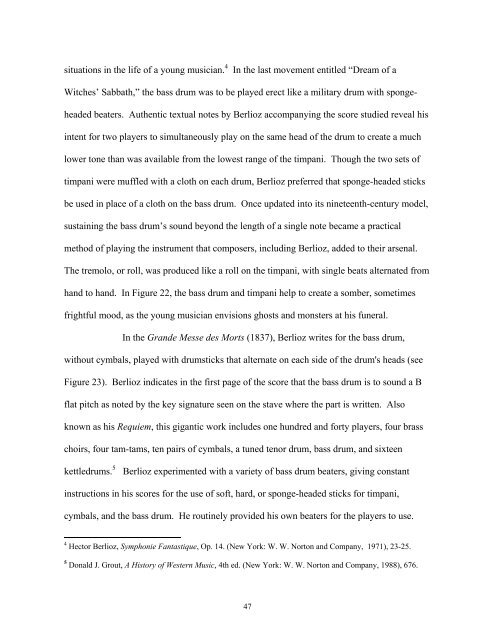THE ROLE OF TURKISH PERCUSSION IN THE HISTORY AND ...
THE ROLE OF TURKISH PERCUSSION IN THE HISTORY AND ...
THE ROLE OF TURKISH PERCUSSION IN THE HISTORY AND ...
You also want an ePaper? Increase the reach of your titles
YUMPU automatically turns print PDFs into web optimized ePapers that Google loves.
situations in the life of a young musician. 4 In the last movement entitled “Dream of a<br />
Witches’ Sabbath,” the bass drum was to be played erect like a military drum with sponge-<br />
headed beaters. Authentic textual notes by Berlioz accompanying the score studied reveal his<br />
intent for two players to simultaneously play on the same head of the drum to create a much<br />
lower tone than was available from the lowest range of the timpani. Though the two sets of<br />
timpani were muffled with a cloth on each drum, Berlioz preferred that sponge-headed sticks<br />
be used in place of a cloth on the bass drum. Once updated into its nineteenth-century model,<br />
sustaining the bass drum’s sound beyond the length of a single note became a practical<br />
method of playing the instrument that composers, including Berlioz, added to their arsenal.<br />
The tremolo, or roll, was produced like a roll on the timpani, with single beats alternated from<br />
hand to hand. In Figure 22, the bass drum and timpani help to create a somber, sometimes<br />
frightful mood, as the young musician envisions ghosts and monsters at his funeral.<br />
In the Grande Messe des Morts (1837), Berlioz writes for the bass drum,<br />
without cymbals, played with drumsticks that alternate on each side of the drum's heads (see<br />
Figure 23). Berlioz indicates in the first page of the score that the bass drum is to sound a B<br />
flat pitch as noted by the key signature seen on the stave where the part is written. Also<br />
known as his Requiem, this gigantic work includes one hundred and forty players, four brass<br />
choirs, four tam-tams, ten pairs of cymbals, a tuned tenor drum, bass drum, and sixteen<br />
kettledrums. 5 Berlioz experimented with a variety of bass drum beaters, giving constant<br />
instructions in his scores for the use of soft, hard, or sponge-headed sticks for timpani,<br />
cymbals, and the bass drum. He routinely provided his own beaters for the players to use.<br />
4 Hector Berlioz, Symphonie Fantastique, Op. 14. (New York: W. W. Norton and Company, 1971), 23-25.<br />
5 Donald J. Grout, A History of Western Music, 4th ed. (New York: W. W. Norton and Company, 1988), 676.<br />
47

















